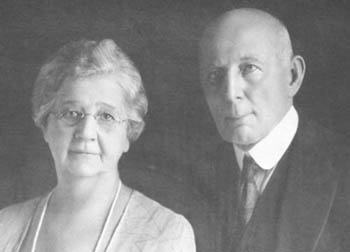
Have you seen the alumnae and students hanging placards and posters resisting structural reformation and tuition raise? Most demonstrations take place in the Pfeiffer Hall, where current president, Shin In-ryung's office locates.
This building might seem old and out of fashion, but it holds great meaning to Ewha as it was the first building built on Ewha's current campus in 1935 and has led the development of Ewha. It is around 3,960m wide, three stories high built of stone and concrete and is located in the center of Ewha.
If you look carefully at the architectural design of the building, Pfeiffer Hall is built a tudor style with pointy roof tops and doors, which originates from England's stet tudor family's home style and the Renaissance period. However, the arches are lower than those of the original tudor style buildings and the windows are square rather than rectangular. These changes occurred as Pfeiffer Hall is not as tall as other buildings built in tudor style. Due to its construction style, it looks noble and elegant despite its small size. This building was appointed as one of 30 registered contemporary cultural properties on May 31, 2002.
The building was named "Pfeiffer Hall" to pay tribute to Mr. and Mrs. Pfeiffer who donated 125 thousand dollars for the building's construction. Their donation was given through Alice R. Appenzeller, Ewha's 6th president, who they met in Philadelphia.
Pfeiffer was a faithful Christian businessman who made his fortune by his own effort. He started off as a pharmacy attendant, while Mrs. Pfeiffer was a weaver at a tailor shop. Although the Pfeiffers earned much, they maintained a simple life and donated their earnings to national and international missionary work. Their total donation amounted to 16 million dollars.
Nevertheless, the Pfeiffer Hall that we see now is not the original structure built in 1935. The building's roof, third & fourth floor, prayer room, and crucifix were destroyed during the Korean War. In 1953, all the destroyed parts of the structure except the cross were restored and the crucifix was finally restored in 1966, on the 80th anniversary of Ewha.
Currently, Pfeiffer Hall is used for administration purposes, but in the past, it contained classrooms for students until June 25, 1950. After the Korean War, the building was used for law classes, human ecology classes, and liberal arts classes.
Next time you pass by the Pfeiffer Hall, pay close attention to its structure and ruminate its history and the meaning it holds in Ewha.
From this issue, this column will search behind the names of buildings around campus, which have been named after specific people in Ewha's history.

